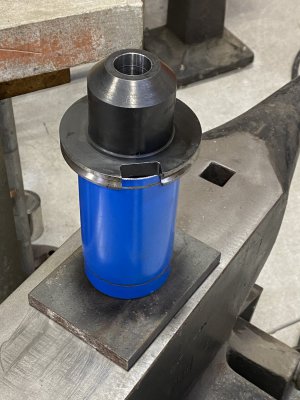Slight update: I moved things around and shortened up the boring bar quite a bit (at least an inch). I also switched to a CCGT 32.50 (1/128" radius) insert. I only had time to make two passes, but I got actual chips this time....still small, but chips rather than dust/sludge. I made a cleanup pass then another pass .010 DOC and there was still a bit of deflection through the hard spot (what I'm calling it for now) but nowhere near as bad, and the amount of taper is way, way better. I'm going to measure it with a telescoping gauge to get real number, but using calipers it seemed pretty straight going back about half way.
I'm going to make a few more passes this weekend and see if it continues to get better. If not, I'm probably going to wait until the CBN inserts show up. I'm still considering annealing the nose of the holder....submerge it in oil up to the flange and then heat it with an oxygen-acetylene torch. I already have a fair amount of experience heat treating and annealing tool steel with that method, so I think I can pull it off without turning it into a pretzel.
Thanks for an update. I'm very interested if those CCGT inserts work better. And aluminium inserts for hard steel? Who could have guessed it?
However CBN insert in a solid carbide boring bar wins hands down. The difference between carbide and CBN (when you try it first) is like between hss and carbide on a machine that can use carbide well. But you'll need to spin that tool holder at 1900rpm. Does your mill go that high in rpm? I know I can't t on my horizontal mill. CBN needs the high speed to generate enough friction to melt the metal. I never tried running CBN slow, but I doubt it will work. The speeds J mentioned are for hardened steel BTW (like the one in this thread). If anyone wants to use CBN for annealed steel for some reason sfpm is even higher (well into the "ludicrous speed" territory).


